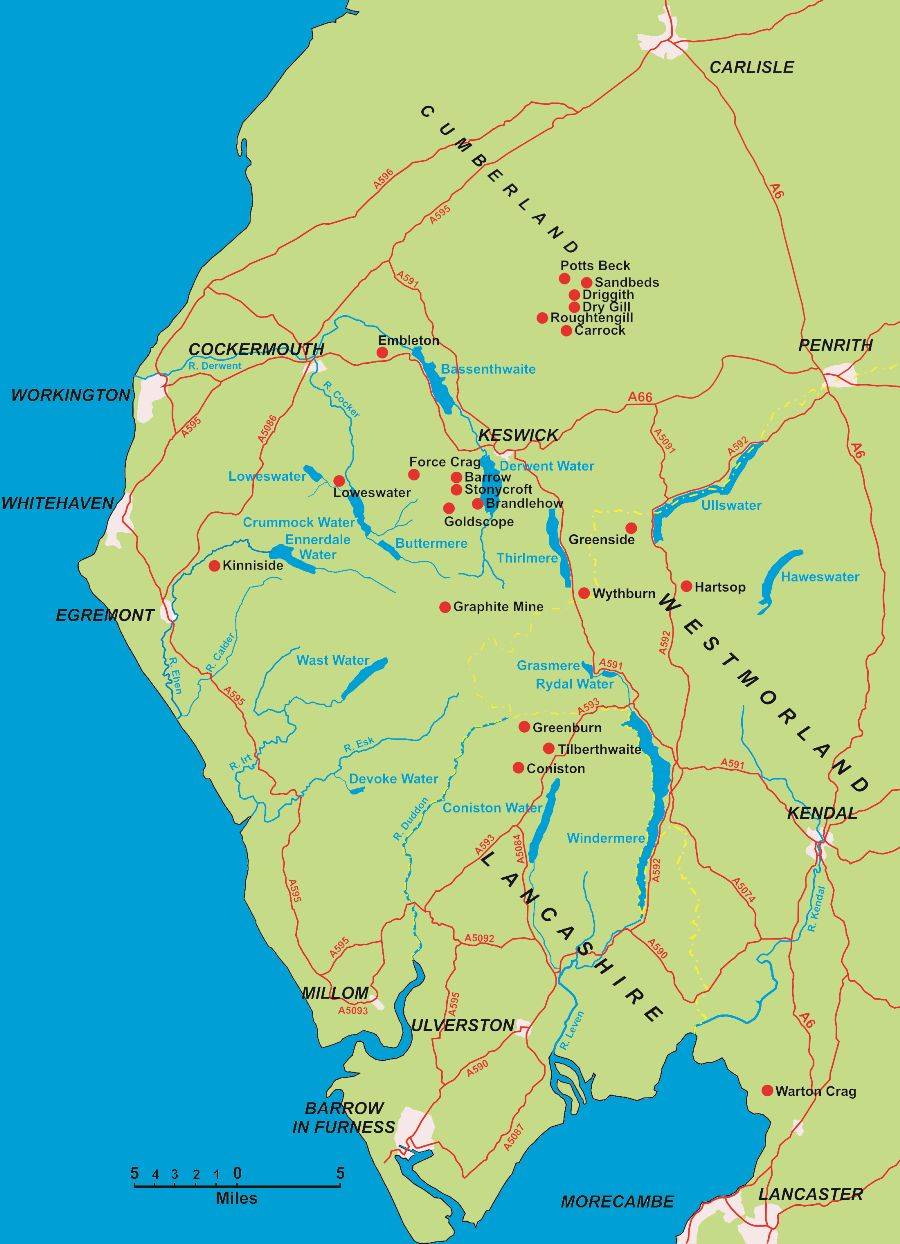This area, now called Cumbria, to the west of the M6, includes the western part of Cumberland, part of Westmorland and North Lancashire. Most of the area covered by the Lake District National Park is made up of three broad bands of rock, trending from SW to NE. They sit across a large granite intrusion, called a batholith, which outcrops in places around the edges of the central massif. The oldest rocks were formed from deep water sediments during the Ordovician period (500 Million Years). These are the Skiddaw Group, which forms mountainous areas to the north and south-west of Keswick. Next, a band of igneous rocks, called the Borrowdale Volcanic Group, crosses the core of the Lakes. It forms the most rugged peaks and developed on a subduction zone where one tectonic plate was pushed underneath another one.
The southern part of the Lakes, from the Duddon estuary to Kendal, is formed by the Windermere Group, which is comprised of slates, siltstones and sandstones deposited in Silurian times (420 Million Years). Magma was then intruded into these rocks, folding and faulting them, and pushing them up to form very high mountains. That was 400 Million Years, but being much softer than the Borrowdale Volcanic Group, they have since eroded to form a belt of foothills.
Around the edges of the National Park are found limestones, coal measures and some more recent Permian and Triassic sandstones.
Most of these rocks have been important, either for the minerals which they host, or like slate and limestone, for their own values. In Neolithic times polished axes made from greenstone, found in a narrow vein of tuff in the volcanic rocks of Great Langdale, were traded across the UK. More recently, slates from southern Lakeland quarries have roofed houses across Britain.
Barytes
This common vein mineral was discarded as valueless by lead miners, but the nineteenth century saw a growing demand for it from the chemical, oil-drilling and nuclear industries.
The northern part of the Caldbeck Fells is crossed from east to west by strong veins of barytes (Barium Sulphate). Mining began in World War I and saw a number of mines worked, or reworked, for barytes until operations ended in 1966 after producing some 150,000 tons of dressed barytes. The relatively low price received for the mineral made the mines susceptible to market fluctuations and mines changed hands regularly.
Near Keswick the Force Crag Mine was worked for barytes periodically until a major collapse in the haulage level force closure in 1990.
Copper
With the exception Coniston, which is in igneous rock, most copper veins have been found in slates which are part of the Skiddaw Group. Except for the veins at Goldscope, near Keswick, and at Coniston, other occurrences of copper have only been small producers.
Iron
The Lake District was blessed with large deposits of very rich hæmatite iron ore, which were found in the limestone along the western and southern edges of the area. Their proximity to the Cumberland coalfield led to large ironworks being established at Workington, Millom and Barrow in Furness. Iron ore was also sometimes mined from veins, like those at Boot in Eskdale.
Iron ore mining and smelting around Egremont were underway by mediæval times, but their scale increased from the mid seventeenth century. The ore was often found as large, irregular masses, or sops. These were worked downwards by removing a slice, or layer, a few feet thick and supporting the roof with large amounts of timber. As the next layer downwards was removed the roof collapsed, eventually forming a crater at the surface.
The industry peaked in the late nineteenth century, and most mines had closed by 1950, but the last mine, Florence near Egremont, continued working in a small way until 2007.
Lead
Most of the lead mines were in the area around Keswick, particularly the Caldbeck Fells and at Greenside near Patterdale.
Plumbago
This very pure form of Graphite was much prized for its lubricating and heat resistance properties. It was also used for making pencils. It was found as irregular lumps in the vein at or near the junction of an igneous intrusion into the Borrowdale Volcanic Group at Seathwaite. Quartz strings, with graphite coatings, led to sops away from the vein.
Tungsten
A rare occurrence of this metal outside south-west England was at Carrock in Mungrisedale, where Scheelite [CaWO4] and Wolframite [(Mn,Fe)WO4] were worked intermittently from 1901 to 1981.
The following pages refer to some of these mines in more detail:
Other sites of interest:
- Ruskin Museum, Coniston, Cumbria, England, LA21 8DU, 015394 41164
- Honister Slate Mine, Honister Pass, Borrowdale, Keswick, CA12 5XN, 017687 77230
- Millom Museum, Old Station Building, Station Road, Millom, LA18 5AA, 01229 772555
- Haig Colliery Mining Museum, Solway Rd, Kells, Whitehaven, Cumbria, CA28 9BG, 01946 599949
Please note NMRS does not have any control over the contents of external websites.
Return to previous page

